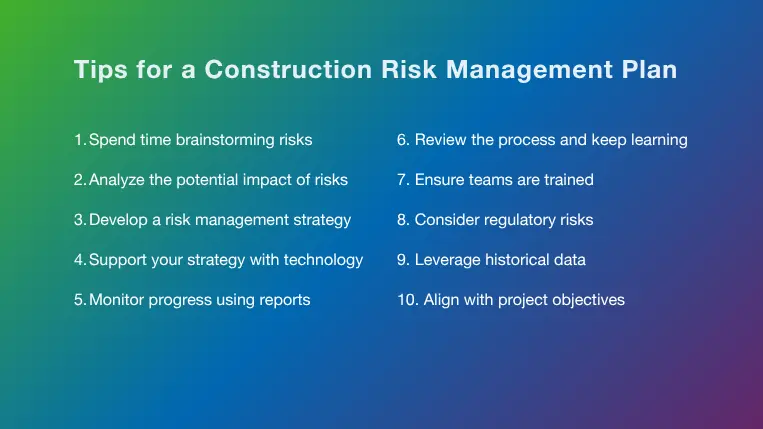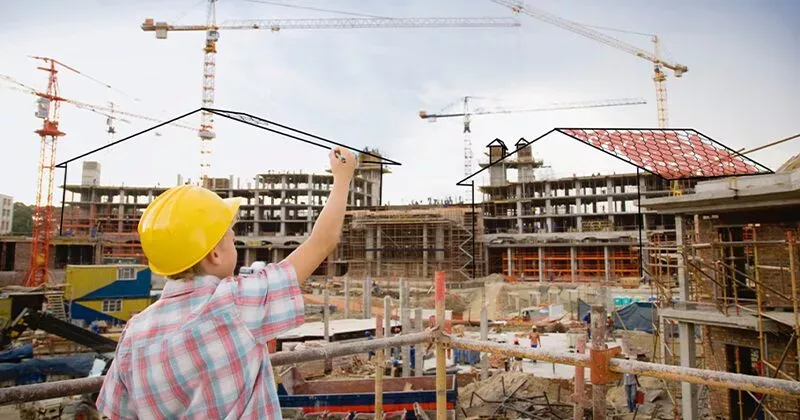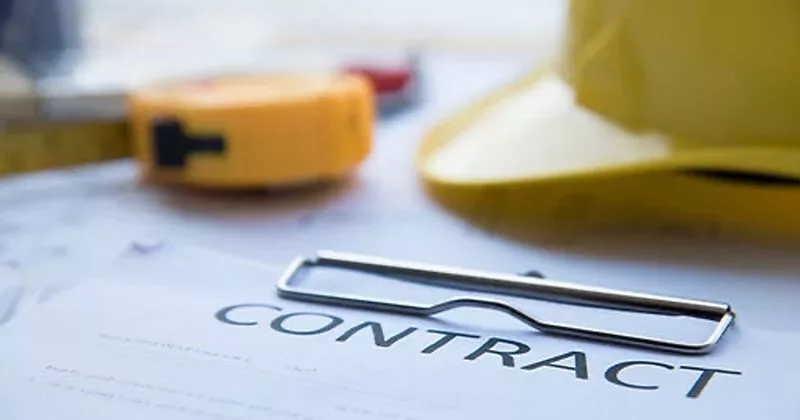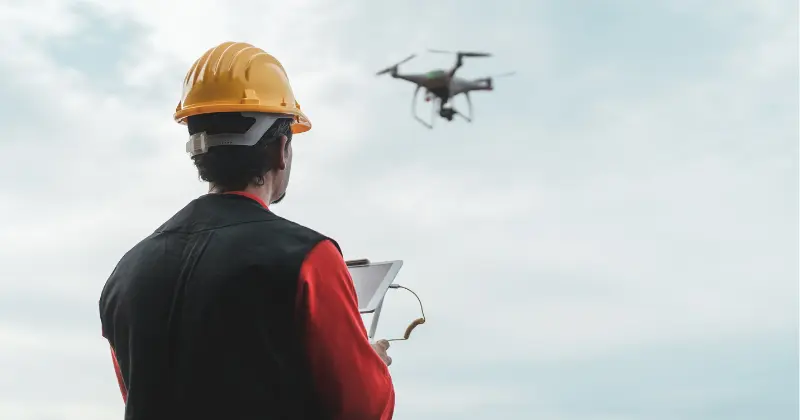11 mins read
Why Construction Risk Management Is Essential For Successful Projects

- What Is Construction Risk Management?
- Understanding Risk in Construction
- The Construction Risk Management Process Explained
- What Are the Benefits of Construction Risk Management?
- What Are Common Construction Risks?
- Tips for a Construction Risk Management Plan
- How Construction Software Supports Risk Management
- Final Thoughts
Every construction project has its own set of risks, ranging from schedule issues and financial concerns to safety, security, and legal risks. Managing construction project risks effectively means identifying issues proactively and taking steps to eliminate them or reduce their impact before they turn into bigger problems. Thankfully, construction management software is now available to help develop and carry out risk management processes that can span multiple projects.
What Is Construction Risk Management?
Risk management in construction is the process of identifying, mitigating, and monitoring the risks related to construction projects. Through proactive discovery and contingency plans, risk management minimizes the likelihood of issues and reduces their impact.
Risk management for construction is more complex than many other sectors since projects vary significantly in size, scope, and personnel, making them more dynamic and less predictable. Every decision includes inherent risks with the potential to delay a project, create safety hazards, or damage client relationships.
No matter the scope or types of risks in construction projects, the same set of risk management principles can be applied to optimize results. The basic steps include identifying and assessing risks, finding ways to manage or eliminate them, and then following up on all identified risks throughout the project to ensure they remain under control.
Understanding Risk in Construction
Businesses of all types and sizes must deal with risk factors, such as supply chain issues, customer buying habits, legal challenges from competitors, and many other variables that bring new challenges each day. Unlike companies operating in more controlled settings, the combination of variable weather conditions, inherently dangerous tasks, heavy (and expensive) equipment, and diverse building materials and methods sets construction risk management apart.
A full 18% of construction workers globally report experiencing harm in the workplace over the past two years, but only 40% say they have received safety and health training on the job. This highlights the gap between risks and mitigation activities that are still found on many job sites, but worker safety is just one of many important risk categories. Design changes, material shortages, contract disputes, and labor issues also play a major role in determining project success.
Dynamic construction projects also involve a wide range of stakeholders and specialists, and no two buildings or situations are exactly alike. Budget problems and cost overruns can be the result of unmitigated risks in other categories, while they also create new risks to project viability when payments are delayed or clients are dissatisfied.
The challenges of risk management in construction can become opportunities when a team-based approach to the process fosters a positive and transparent culture, while improving collaboration among stakeholders.
The Construction Risk Management Process Explained

Risk management for construction requires proactive, cross-functional commitment, along with a set of standard practices to guide teams through the process. Over time, the steps involved in establishing a risk management program have become well-defined and standardized throughout the industry.
Identification
Risk identification is the process of uncovering all risk factors that can potentially impact a project, including everything from weather events and labor strikes to design changes and safety issues. This process can be time-consuming, but it is essential to leave no stone unturned when identifying project risks as input for the steps that follow.
Assessment
The risk assessment phase is where probability and statistics enter the picture to help manage a potentially long list of risks. Each factor is assigned a numeric score based on the severity (impact) of the potential consequences, and another score based on the likelihood of occurrence. These two scores are then multiplied to determine the risk priority number (RPN) for each factor as compared to others. Historical data from previous, similar projects helps to accelerate this assessment process.
Planning
The planning phase of project risk management in construction is when the strategies are developed to either avoid, mitigate, transfer, or accept each risk based on the relative priority and available options. A supply chain risk might be avoided altogether by removing scarce materials from the design, while weather-related risks can only be accepted as inevitable or mitigated through construction contingencies. The planning phase yields a risk management plan with specific actions defined to address each risk.
Mitigation
While avoidance and acceptance are not uncommon responses, most construction risks are addressed through mitigation. This means taking specific steps to reduce the likelihood or impact of each risk, or both. For example, the impact of ongoing labor shortages can be reduced by extending the project timeline to accommodate delays, while the likelihood can be reduced by signing subcontractors to legally binding contracts prior to project start.
Monitoring & Reporting
The construction risk management process does not end with mitigation. In fact, this is just the beginning. A strong risk management program requires continuous follow-up to ensure control measures remain effective and to identify and address any new risks that emerge during construction. The status of the program should be reported regularly to clients and the key stakeholders who participated in the earlier stages.
What Are the Benefits of Construction Risk Management?
Risk management in construction projects aligns with overall project objectives, including timely completion, staying on budget, and keeping workers safe. Each project team already encounters current or potential risks and takes steps to correct them. Risk management processes apply a more structured approach, utilizing a construction risk management plan and other tools to help evaluate and track risks more effectively.
Minimizing Unexpected Costs
Construction schedules and budgets must be adhered to for a project to be successful. Issues like design flaws or supply chain issues might go undetected for months without proper risk management, creating an avoidable crisis late in the project. Prioritizing risks also reduces costs by avoiding rework and directing resources to where they are needed most.
Improving Worker Safety
No matter how well-trained and prepared contractors, project managers, and workers are, environmental hazards and accidents are always a major concern on construction sites, with the total cost of injuries exceeding $170 billion each year in the U.S. One of the primary benefits of risk management is the improved worker safety that comes from early hazard identification, regular safety inspections, and the elimination of unsafe working conditions.
Informed Decision Making
The principles of risk management in construction include a focus on data collection to help uncover important risks and estimate their impact and likelihood of occurrence. These efforts also help project managers, stakeholders, and clients get a realistic view of the overall project and the issues they need to be aware of. This approach introduces data-driven decision-making and minimizes guesswork by applying logic and data to evaluate important project issues.
What Are Common Construction Risks?

The combination of heavy machinery, fast-paced schedules, outdoor conditions, large crews, and new design elements can create a long list of risks that must be considered. These risks tend to fall into a few primary categories.
Safety Hazards
Unsafe job sites and safety hazards are an ongoing concern in the building industry. According to the National Safety Council, construction is one of the most dangerous industries. Mitigating hazards before they lead to accidents, violations, or other problems is essential. When risks are rated according to their impact and severity, any hazards that potentially impact job site safety should be considered critical.
Financial Issues
Construction risks with financial consequences don’t always have life-or-death implications, but they can still lead to cash flow interruptions, supply chain issues, and other problems that put the project outcome in jeopardy. Delayed payments, rising material costs, fraud, and other unpredictable financial risks can drain funds and put projects at risk. Even small budget overruns can make it difficult to meet payroll and stay on schedule when the root cause is not addressed early in the life of the project.
Operational Mishaps
Problems like labor shortages, incomplete designs, frequent change orders, equipment failures, and environmental factors are often unavoidable in construction. They also represent risk factors that need to be assessed and mitigated early on. While the immediate consequences of these issues may not be apparent, a thorough risk assessment can point to downstream effects like rework, long delays, and reputational damage that must be prevented or mitigated to ensure project success.
Legal Problems
Construction disputes, industry regulations, and contract violations can also present risks, with the average cost of construction litigation in North America exceeding $40 million per case. Legal issues can also damage client relationships and increase scrutiny of projects and teams. Early identification of legal risks, maintaining complete documentation and records, and conducting regular site audits throughout the project can prevent legal issues from impacting project success. Professional construction contract management software can help you keep everything in check.
Tips for a Construction Risk Management Plan

Construction risk management software, risk matrix templates, and other available tools make it easier to create a risk management plan and conduct an appropriate analysis. No matter what tools and software you apply, effective risk management comes from following established best practices.
1. Spend time brainstorming risks
A commitment to cross-functional brainstorming maximizes the value of starting the risk management process early in the project lifecycle, ideally during the preconstruction planning phase. The project team should consider and document any known or potential risk factors related to design, safety, resources, financial flow, regulations, and environmental conditions. No risk factors should be discounted, even if they are deemed unlikely to happen. It is also important to avoid jumping to solutions during this early stage of the process.
2. Analyze the potential impact of risks
Risk analysis requires some creativity and out-of-box thinking for the team to answer questions like:
- What is the worst-case scenario?
- Has this ever happened before?
- How likely is this to happen in the future?
- How would this impact the success of the project?
Answering these questions allows you to assign risk priority scores to each factor more accurately. For example, a serious safety issue that is likely to happen daily is both likely and severe and should become a top priority for risk mitigation. However, the risk of occasionally overspending on transportation or company meals should be noted but probably won’t require any immediate corrective action.
For hypothetical scenarios that are possible but have never happened before, the team should err on the side of caution when weighing the impact. If it is deemed unlikely, this will feed into the risk analysis when it comes time to prioritize corrective actions and resources in order of importance.
3. Develop a risk management strategy
For each risk you identify, you will need to decide whether it can be avoided, mitigated by direct action, or simply accepted when there is no possible alternative. Environmental risks like earthquakes and heat waves are examples of risks that must be accepted but should still have contingencies, such as an insurance policy or a longer timeline, to work around them.
Well-defined policies and response procedures are essential since they provide much-needed guidance if an incident occurs. These policies and procedures should include communication plans, roles and responsibilities, and specific actions that must be taken to prevent further damage and expedite recovery. This ensures that the project can quickly return to normal operations to minimize the overall impact of the risk.
4. Support your strategy with the right technology
Identifying, analyzing, and tracking risk factors for large construction projects is almost impossible without the right construction risk management software. Available tools help automate the risk management process while providing built-in templates that make it easier to find and organize data in real-time. Cloud-based construction software and collaboration tools are especially helpful since they allow stakeholders to communicate and view the same information no matter where they are.
Building information modeling (BIM) software has proven to be an effective tool for designers, architects, and project managers since it allows them to model and test concepts in the virtual world. BIM is also useful for predicting issues prior to construction and modeling potential risk factors like change orders and weather extremes to better understand their impact.
5. Monitor progress using reports
The importance of risk management in construction means it should never be a one and done process. Strategic, operational, and structural solutions will be developed that require the project team to correct problems, update the project scope, or improve awareness in real-time.
After the risk management plan is created, these follow-up actions require ongoing monitoring to ensure they have been implemented and have successfully addressed the risks. Construction management software makes it easier to generate and share reports to keep all stakeholders up to date on the status.
6. Review the process and keep learning
Continuous improvement can be another important benefit of risk management in construction projects when the lessons learned from each project are shared and carried on to the next. For example, if a building design concept leads to a potentially hazardous task for workers during the build, this information should be captured in the risk management database to prevent the same situation from impacting future projects.
Risk management processes rely on software and technology, but they also rely on teamwork, collaboration, and participation to ensure the right issues are explored and addressed. With these elements working in harmony, each new project continues to build upon this winning foundation.
7. Ensure teams are trained
Cross-functional teams performing the brainstorming, analysis, and mitigation, already possess the skills required for effective risk management in construction projects, but it is still important to implement risk training programs to keep everyone up to date on the latest tools and practices. Training also helps to ensure compliance with industry standards and allows team members to complete the process more efficiently.
Formal training programs and documented procedures empower all employees to identify risk factors on and off the construction site more easily, and understand how and why they should be reported.
8. Consider regulatory risks
The principles of risk management in construction are primarily based on financial, safety, and operational risks, but regulatory risks should not be overlooked. Changes to zoning, environmental regulations, building codes, safety standards, and other regulations can impact the viability and timeline of a project, so these risks should be carefully documented and prioritized.
In many cases, it is impossible to avoid or transfer regulatory risks, so contingency planning can be a useful mitigation strategy when thinking through the potential consequences of regulatory issues and how they can be minimized.
9. Leverage historical data
A risk management plan for a construction project is likely to include a long and diverse list of risk factors, so scoring and prioritizing each risk individually can become a daunting and time-consuming task. The best risk management programs utilize a combination of software and historical data to create a database of common risk factors and standard ratings. While the severity and likelihood of each risk is also project-dependent, historical data provides a baseline to assist in the evaluation process.
10. Align with project objectives
If every situation was alike, creating a risk management plan for a construction project would be a simple matter of copying and pasting historical information. However, the range of design choices, site locations, materials, client preferences, and many other factors make it important to weigh risks based on key project objectives.
For example, a project with limited tolerance for budget increases might rank the severity of risks like design changes and rework higher, while projects with fixed timelines might place more emphasis on labor or material shortages likely to cause delays.
How Construction Software Supports Risk Management

The importance of risk management in construction, along with the growing complexity of building and infrastructure projects, makes it essential to utilize software tools whenever possible to streamline workflows, organize information, perform calculations, and capture ongoing activities. Thankfully, there are many types of construction software available to support these tasks.
BIM Models
BIM originated in the 1970s as part of an ongoing effort to migrate construction design, testing, and planning processes into the digital realm. As more companies adopt BIM management software for their project teams, the benefits of BIM as a construction risk management tool also become apparent. BIM models eliminate the guesswork and uncertainty associated with design, construction method, and sustainability choices by allowing various concepts to be vetted digitally.
As the industry moves from 3D BIM models to 4D (time and schedule), 5D (cost estimation), 6D (sustainability) and beyond, BIM will continue to reduce project risks in multiple areas by modeling multi-faceted project scenarios and fostering a better understanding of their impact and likelihood.
Mobile Technology
Mobile devices and tablets provide major productivity, quality, and cost benefits, and they are also reshaping construction risk management. Mobile technology helps to eliminate the lags in communication that once allowed important safety, quality, and build issues to be underreported or forgotten at the end of a long shift. Mobile technology is also becoming a driving force behind new risk mitigation strategies, including wearable technology to monitor workers in hazardous environments, and augmented reality (AR) glasses to layer warnings, alerts, or instructions over real-time images in the field.
Cloud-Based Accessibility
The cloud makes it possible for all stakeholders to access or share project information using a centralized database, and improves the data management and analytics necessary for risk management in construction. Stakeholders can leverage the cloud to brainstorm and document risk factors collectively, even from separate work locations. Construction software as a service (SaaS) applications allow for continuous monitoring of risks, along with built in analytics and templates to streamline the entire process.
Collaboration Tools
Mobile technology, cloud computing, and BIM all help to improve collaboration among team members to build a solid risk management foundation. General collaboration platforms offer the file sharing and communication features that bring teams together more easily for risk management activities, while purpose-built collaboration software might also include useful dashboards, editable risk registers, and reporting features designed specifically for risk management in construction.
Task and Schedule Tracking
Tracking, scheduling, and documenting the tasks generated through construction risk management can be challenging without versatile software tools to capture and organize this information more effectively. The best project and risk management tools seamlessly integrate mitigation activities into the overall schedule, while ensuring adequate resources are available to complete these tasks without compromising other important design, quality, or management functions. Real-time risk management information that includes up-to-date mitigation progress provides a useful snapshot into the overall project risk profile for key stakeholders and clients.
Final Thoughts
Risk management presents opportunities to save time and money while creating a safer and more harmonious work environment for everyone involved. Construction management software has turned what was once an intimidating, complex process into a valuable exercise that brings important issues to the attention of the right stakeholders.
At RIB Software, we provide a full suite of construction management tools to make construction collaboration, benchmarking, planning, design, and project handover seamless and effective. With fully traceable documentation organized in a secure, cloud-based environment, our innovative portfolio of solutions weaves a digital thread connecting past, ongoing, and future projects to identify and prevent common risks.
If you are ready to take more control of your construction risk management, get a free demo of RIB Software solutions today!
Most Recent
11 mins read
10 mins read
10 mins read
29 mins read
Blog Categories

Ebook











